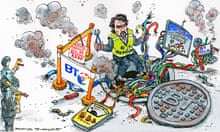It has been one of the eternal questions of the Premier League era, echoing down the years as kits have got tighter and wage packets heavier. Will the bubble ever burst? Will the seemingly insatiable demand for the product ever level out? Will the thirst of giant media companies for live top-flight action in order to grow and retain their customer bases ever run dry? Will the exponential growth in TV rights income at home and abroad that has fuelled the endless inflation of the Premier League’s high-octane balloon ever level off?
Every time the question has been posed, the answer has come back ever more emphatically: no. Just as one tectonic plate appears to be shifting, another slots into place to take broadcasting income to new heights.
The bitter competition between Sky and BT Sport, both desperately using sport as a weapon in the battle for customers across TV, broadband, telephone and mobile, plus the increasing demand across the world in an international market that is still far from sated, drove the latest Premier League TV deal beyond £8.3bn over three seasons. BT shelled out almost £1bn for the Champions League over the same period, while the FA has just brought in around £820m over six seasons for the international rights to the FA Cup alone.
Received wisdom, in the US and the UK, remains that in a fracturing, splintering media landscape top-notch live sport remains one of the only types of content for which viewers will make an “appointment to view”. Since Rupert Murdoch famously bet the farm on Premier League football to rescue Sky TV in 1991, it has been the catnip that has underpinned subscriber loyalty and, even in a far more complicated media landscape, is seen as so vital as to be worth almost any price.
And yet, arresting figures suggesting a decline in early season ratings have prompted an outbreak of soul‑searching at those broadcasters and head‑scratching among analysts. Early season ratings for live Premier League matches on Sky Sports are down by a fifth. On one particular Tuesday, BT Sport’s Champions League figures were down by 40%. Could the unthinkable be happening? Could fans finally be turning off? This has coincided with more deep-seated fears in the US, where NFL coverage, for which broadcasters and cable carriers have collectively shelled out more than $50bn for rights into the early 2020s, has suffered a double-digit decline in viewers this season.
A recent article in the Atlantic magazine posited four possible culprits: the presidential debates (short-term displacement of viewers), cord cutters (the phenomenon in the US of cable customers cancelling their subscriptions in favour of streaming services such as Netflix), Twitter streams (the ability to catch up with games without actually watching them) and Peyton Manning (not just him, but a perceived lack of superstars). The NFL commissioner, Roger Goodell, was forced on to the defensive last week. “There a lot of factors to be considered,” he said. “We don’t make excuses. We try to figure out what’s changing.”

Could something similar be happening here? Is this a blip or a trend? Are changing viewing habits simply leading people to watch in different ways or is the vast smorgasbord of football on offer throughout the season finally starting to give viewers indigestion as the endless stream of action becomes a blur?
Beneath those isolated figures, the picture is inevitably a lot more complex. Sky and BT point to seasonal or one‑off factors that make year-on-year comparisons dangerous until later in the season. The Olympics, the weather and a comparative lack of heavyweight clashes so far this season have been cited as reasons for the drop in viewers. BT can reasonably point to the fact that matches involving teams with a smaller fanbase, such as Leicester City, in the Champions League are inevitably going to attract fewer viewers.
Perhaps inevitably, one reason its Champions League ratings are down and its Europa League figures are up is because Manchester United are playing on Thursday nights this season. Sky says that the first genuine heavyweight clash of the season – the disappointing goalless draw between Liverpool and United on the preposterously billed “Red Monday” – recorded the best figures for three years, with an average of 2.8m viewers.
Even apparently minor factors, such as the relegation of well-supported teams such as Newcastle United and Aston Villa, can have an effect on the numbers watching at home and in pubs. Both broadcasters can also reasonably point to technological and cultural shifts, which are not captured by the conventional ratings measures, as reasons why the figures are more difficult to parse than they once might have been.
BT Sport and Sky Sports heavily promote viewing through apps available on smartphones and tablets. BT’s viewing online and via its app is understood to have increased by 17% this season. In addition to pushing its Sky Go service for subscribers and an attendant new “match centre” app, Sky has focused significant investment in promoting its Now TV service. That allows non-subscribers to dip in and out of Sky Sports and other channels on a day-by-day basis and also does not feature in the headline ratings.
Simon Green, the head of BT Sport, told the Guardian that picking out ratings on linear television on individual match nights and comparing them with last season was only one factor by which they measured success.
“Viewing figures will fluctuate on a day-to-day basis and are influenced by many factors, including the team and the size of their fan base, other events happening on the day or even the weather,” he said. “Barb [the Broadcasters’ Audience Research Board] viewing figures are just one of many ways in which we measure the success of BT Sport and only give part of the picture.”
He added: “Viewing figures help us make decisions about programming and rights, but the most important measure is our overall business performance and these are reported every quarter to the City. BT is happy with the impact that BT Sport has made and the content that we are showing on the channels.”
He said the danger of stripping out figures for a single Tuesday was borne out by the fact that ratings across both Champions League nights were up on the corresponding week last season.
“Viewing figures on a Champions League night will depend on which teams are playing, what the stage of the competition is and who they are playing,” he said. “For match-day three we have had a cumulative sum in-match viewing figure of 2.3m versus 2.1m last season.”
At Sky Sports the managing director, Barney Francis, is similarly bullish, emphasising the breadth of choice provided by the broadcaster and, interestingly, pointing out that ratings in other sports – and the Football League – are up. “Sky Sports gives customers an unrivalled breadth of sport in a multitude of ways, encouraging them to engage with sport in the way that suits them,” he said. “This is demonstrated by our consumption; we’ve shown the top 15 most viewed Premier League games this season including Liverpool v Man United at 2.8m average, the highest ratings in three years.

“Viewing of F1, EFL and cricket is up strongly year on year, and The Open saw a reach of 8m on TV and 2.8m unique users online. Through our growing digital platforms and apps, On Demand service and Now TV offering, there is something for every sports fan.”
These captains of the sports broadcasting industry, whose necks are ultimately on the line for the billions they have pledged to the sports they bring to their viewers, are of course biased witnesses. Could something else be going on here?
For years, the Premier League has fought a largely beneath-the-surface war on piracy. It has waged a high‑profile legal battle against pubs beaming in coverage from abroad while using specialist technology companies to try to close down illegal streams at source.
But now that just about every household has fast enough Wi-Fi to make streaming illegal streams to a phone, tablet or laptop a reality, that effort feels increasingly like the modern equivalent of sticking a finger into a leaky dyke.
Up to now, a concerted effort by Sky and BT to ensure that they provide their subscribers with enough quality and breadth to make streaming illegally just too much hassle, combined with the fact their numbers have continued to grow regardless, has made it another dog that has failed to bark. But if those who have shelled out more than £5bn for domestic rights start to feel that their ratings are being compromised, expect them to put more pressure on the rights owners to do something about it.
Of course, for BT and Sky the only real metric that matters is whether people are giving up their subscriptions. If viewing patterns fluctuate and fans snack on football in different ways that is fine by them – as long as those supporters are still shelling out every month and are happy with the breadth and range of content and technology on offer.
Even more difficult to analyse is whether cultural factors are having an effect. Clearly, the internet, social media and video games are having an effect on the way that younger fans in particular interact with the game.
Are younger people watching football in a different way? Is the sport now so all-pervasive that actually watching a full match is becoming a tedious inconvenience if the relevant action and talking points can all be absorbed via osmosis on Twitter and other social media channels?
That might seem an extreme analysis, and certainly the sanctity and thrill of the live occasion remains for most fans, but it is one that Sky clearly recognises – for the first time this season, the broadcaster is pushing out selected goal clips for nothing over Twitter as matches take place. But the theory gives rise to an intriguing thought experiment – could the very ubiquity of the modern game, its endless noise and hype, eventually start to eat away at the exclusivity that has fuelled its growth over the past two decades. In short, will it finally eat itself? More likely is that fans will continue to make an “appointment to view” for the biggest matches but that they could become fewer and further apart.
But it could also be true that as the market becomes ever more complex and austerity continues to bite, more viewers will start to feel that the amount they shell out every month to gorge on sporting action is an expense too far and look at ways to mitigate it - whether that is switching to an a la carte service such as Now TV or taking their chances with a streaming service.
In a recent note, the media analysts Enders said that the same factors that were driving US “cord cutters” were not present to the same extent in the UK. It doubted that the same dynamics existed in the UK market and recent results from Sky and BT showed continued growth.
There is certainly no sense of panic from the Premier League’s headquarters in Gloucester Place, with the overall feeling being that it is far too early to judge whether the early season numbers are a blip or a trend.
And yet, beneath the bullish exterior, senior broadcasting sources are also starting to quietly question whether rights owners are doing their bit in return for the billions poured into sport since the satellite television revolution began in the late 1980s. On both sides of the equation – rights owners and broadcasters – the stakes have been raised to almost unimaginable levels. What happens next will be fascinating. Stay tuned. Or not.










Comments (…)
Sign in or create your Guardian account to join the discussion